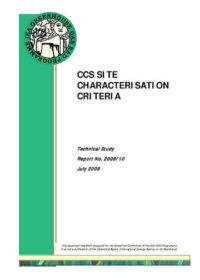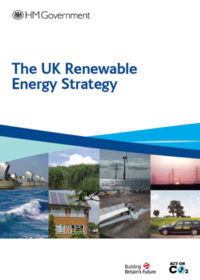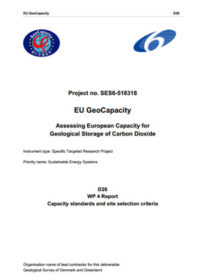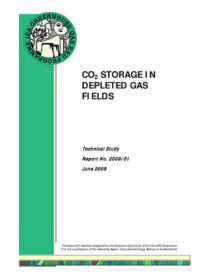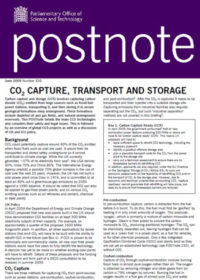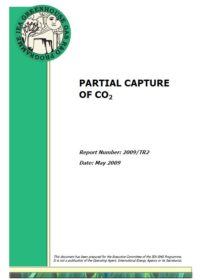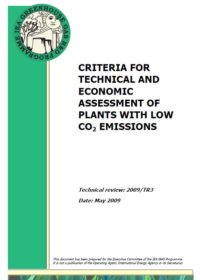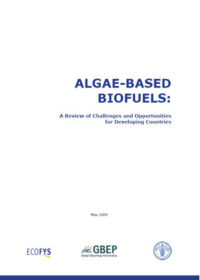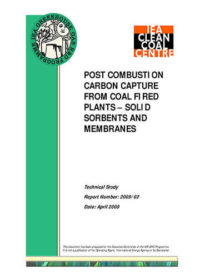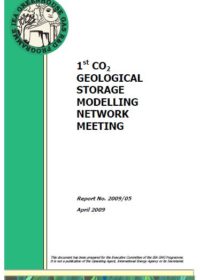Resources
Publications
Our publications, reports and research library hosts over 500 specialist reports and research papers on all topics associated with CCS.
View our Publication Library Disclaimer.
Filter by
CCS site characterisation criteria
1st July 2009
Topic(s): Carbon capture use and storage (CCUS), CO2 storage
The IEA Greenhouse Gas R&D Programme (IEA GHG) has recently commissioned the Alberta Research Council in Canada to conduct a review of storage site selection criteria and site characterisation methods in order to produce a synthesis report. Among the various elements of the CO2 capture and storage (CCS) chain, the stage of storage site selection and characterisation is of critical importance because any storage site must demonstrate that it satisfies three fundamental requirements:
- capacity to store the intended volume of CO2 over the lifetime of the operation,
- injectivity, to accept/take CO2 at the rate that it is supplied from the emitter(s),
- containment, to ensure that CO2 will not migrate and/or leak out of the storage unit (safety and security of storage).
This report reviews the literature on the subject on site selection and characterisation since the publication of the IPCC Special Report on CCS, and provides a synthesis and classification of criteria.
Disclaimer
The content within the Global CCS Institute Publications, Reports and Research Library is provided for information purposes only. We make every effort and take reasonable care to keep the content of this section up-to-date and error-free. However, we make no claim as to its accuracy, currency or reliability.
Content and material featured within this section of our website includes reports and research published by third parties. The content and material may include opinions and recommendations of third parties that do not reflect those held by the Global CCS Institute.
The UK renewable energy strategy
1st July 2009
Topic(s): Domestic policy, Economics, Energy security, Policy law and regulation, Renewables
This strategy document explains how the UK Government will radically increase its use of renewable electricity, heat and transport to meet its legally-binding target to ensure 15% of its energy comes from renewable sources by 2020. The document describes how the United Kingdom will tackle climate change, reducing emissions of CO2 by over 750 million tonnes between 2009 and 2030. It will also promote the security of the UK’s energy supply, reducing overall fossil fuel demand by around 10% and gas imports by 20–30% against what they would have been in 2020. And it outlines opportunities for the UK economy with the potential to create up to half a million more jobs in the UK renewable energy sector resulting from around £100 billion of new investment. In parallel with energy saving, nuclear and carbon capture and storage, this is a key element of the nation’s overall transition plan for setting the UK on the path to achieve a low-carbon, sustainable future that helps address dangerous climate change.
Disclaimer
The content within the Global CCS Institute Publications, Reports and Research Library is provided for information purposes only. We make every effort and take reasonable care to keep the content of this section up-to-date and error-free. However, we make no claim as to its accuracy, currency or reliability.
Content and material featured within this section of our website includes reports and research published by third parties. The content and material may include opinions and recommendations of third parties that do not reflect those held by the Global CCS Institute.
Assessing European capacity for geological storage of carbon dioxide. D 26, WP 4 report: capacity standards and site selection criteria
16th June 2009
Topic(s): Carbon capture use and storage (CCUS), CO2 storage
The GeoCapacity project assesses European capacity for geological storage of CO2 in deep saline aquifers, oil and gas structures and coal beds. This publication reports on the site selection criteria required when considering sites for geological storage. It presents a site ranking methodology based on geological suitability for CO2 storage and on data availability and confidence.
Disclaimer
The content within the Global CCS Institute Publications, Reports and Research Library is provided for information purposes only. We make every effort and take reasonable care to keep the content of this section up-to-date and error-free. However, we make no claim as to its accuracy, currency or reliability.
Content and material featured within this section of our website includes reports and research published by third parties. The content and material may include opinions and recommendations of third parties that do not reflect those held by the Global CCS Institute.
CO2 storage in depleted gas fields
1st June 2009
Topic(s): Carbon capture use and storage (CCUS), CO2 storage
Three main CO2 geological storage scenarios may currently be considered as technologically-advanced – deep saline formations, depleted oil fields as part of enhanced oil recovery (EOR) schemes, and depleted natural gas fields. Much attention is currently focussed on deep saline formations due to these providing the largest theoretical global storage resource (10,000Gt according to the 2004 IPPC Special Report), and on CO2-EOR schemes due to the potential economic benefits. However, depleted gas fields offer significant advantages for CO2 storage: proven capacity and sealing structures to give confidence in storage security; and the presence of existing infrastructure that may be suitable for re-use in storage operations. Whilst some technical challenges remain – for example, controlling the flow of injected CO2 into de-pressurised formations where aquifer ingress is low or absent – storage in depleted gas fields could be regarded in some locations as an ‘early’ opportunity for large scale commercial storage. The southern North Sea provides an example of such a location, where a number of large fields are rapidly approaching exhaustion of recoverable natural gas reserves.
A key objective of this work is to advance the analysis undertaken in the IEA GHG report Barriers to overcome in implementation of CO2 capture and storage: Storage in disused oil and gas fields, which identified a total potential worldwide capacity of 923 Gt CO2, in depleted gas fields, of which 797 Gt is in depleted gas fields.
Disclaimer
The content within the Global CCS Institute Publications, Reports and Research Library is provided for information purposes only. We make every effort and take reasonable care to keep the content of this section up-to-date and error-free. However, we make no claim as to its accuracy, currency or reliability.
Content and material featured within this section of our website includes reports and research published by third parties. The content and material may include opinions and recommendations of third parties that do not reflect those held by the Global CCS Institute.
Carbon capture and storage (CCS) involves capturing carbon dioxide (CO2) emitted from large sources such as fossil fuel power stations, transporting it, and then storing it in secure geological formations deep underground. These formations include depleted oil and gas fields, and natural underground reservoirs. This POSTnote details the main CCS technologies and considers their safety and legal issues. This is followed by an overview of global CCS projects as well as a discussion of UK and EU policy.
Disclaimer
The content within the Global CCS Institute Publications, Reports and Research Library is provided for information purposes only. We make every effort and take reasonable care to keep the content of this section up-to-date and error-free. However, we make no claim as to its accuracy, currency or reliability.
Content and material featured within this section of our website includes reports and research published by third parties. The content and material may include opinions and recommendations of third parties that do not reflect those held by the Global CCS Institute.
The first E-News update from the Global CCS Institute with information on our activities and accomplishments in the field of CCS.
Disclaimer
The content within the Global CCS Institute Publications, Reports and Research Library is provided for information purposes only. We make every effort and take reasonable care to keep the content of this section up-to-date and error-free. However, we make no claim as to its accuracy, currency or reliability.
Content and material featured within this section of our website includes reports and research published by third parties. The content and material may include opinions and recommendations of third parties that do not reflect those held by the Global CCS Institute.
This report is a brief review of the technology and costs of partial capture of CO2. The report does not attempt to prescribe policies for mandating CO2 capture and whether partial capture should be part of a policy for reduction of greenhouse gas emissions. IEA GHG provides technical information which can be used by policy makers but it does not intend to be policy prescriptive.
Disclaimer
The content within the Global CCS Institute Publications, Reports and Research Library is provided for information purposes only. We make every effort and take reasonable care to keep the content of this section up-to-date and error-free. However, we make no claim as to its accuracy, currency or reliability.
Content and material featured within this section of our website includes reports and research published by third parties. The content and material may include opinions and recommendations of third parties that do not reflect those held by the Global CCS Institute.
Criteria for technical and economic assessment of plants with low CO2 emissions
1st May 2009
Topic(s): Carbon capture use and storage (CCUS), Policy law and regulation
The IEA Greenhouse Gas R&D Programme (IEA GHG) undertakes studies to assess technologies for abatement of greenhouse gas emissions. IEA GHG has concentrated on CO2 capture and storage (CCS) applied to power generation but it has also assessed CCS in other industries and will compare the relative merits of CCS and alternative greenhouse gas abatement options. Soon after IEA GHG started operation in 1991 it produced a set of standard technical and economic criteria for assessment of power plants with capture to ensure that its studies are undertaken on a consistent basis, as far as possible. These criteria have continued to be used since then, with some minor modifications.
In the time since IEA GHG was set up, economic conditions have changed, knowledge of CCS and other technologies has increased and IEA GHG has been undertaking increasingly detailed studies. In response to these changes IEA GHG has decided to revise and expand its assessment criteria. As a starting point IEA GHG’s criteria for new power plants with CO2 capture have been updated and some general guidelines for assessment of other types of plant with CO2 capture have been included. These changes are described in this report. Future work will look to expand the criteria to encompass retrofit of CO2 capture, the full CCS chain including CO2 transport and storage and non-CCS energy technologies. In the mean time a notional cost of CO2 transport and storage shall be assumed and sensitivities to a range of costs shall be assessed.
Disclaimer
The content within the Global CCS Institute Publications, Reports and Research Library is provided for information purposes only. We make every effort and take reasonable care to keep the content of this section up-to-date and error-free. However, we make no claim as to its accuracy, currency or reliability.
Content and material featured within this section of our website includes reports and research published by third parties. The content and material may include opinions and recommendations of third parties that do not reflect those held by the Global CCS Institute.
Algae-based biofuels: a review of challenges and opportunities for developing countries
1st May 2009
Topic(s): Biofuels / Bioenergy, Renewables
Food and Agriculture Organization of the United Nations prepared this paper on algae-based biofuels in 2009 as a reference platform for possible future work of the Organization. The lead author of the paper was Sjors van Iersel from Ecofys.
Some of the main characteristics which set algae apart from other biomass sources are that algae (can) have a high biomass yield per unit of light and area, can have a high oil or starch content, do not require agricultural land, fresh water is not essential and nutrients can be supplied by wastewater and CO2 by combustion gas.
Disclaimer
The content within the Global CCS Institute Publications, Reports and Research Library is provided for information purposes only. We make every effort and take reasonable care to keep the content of this section up-to-date and error-free. However, we make no claim as to its accuracy, currency or reliability.
Content and material featured within this section of our website includes reports and research published by third parties. The content and material may include opinions and recommendations of third parties that do not reflect those held by the Global CCS Institute.
Capturing carbon, tackling climate change: A vision for a CCS cluster in the South East
4th April 2009
Topic(s): Carbon capture use and storage (CCUS)
The review recommends that the collected CO2 is combined into a pipework network that links the area to depleted gas fields, such as the Hewett Field. There is sufficient storage to absorb over 60 years of CO2 emissions from the Thames Cluster. There is additional storage available in other gas and oil fields and further storage in aquifers.
It is most cost effective to start a CCS cluster by capturing CO2 from the largest emitters first. These provide the flow rates to justify a pipeline network. In the area of the Thames Estuary there are eight sites (seven power plants and a refinery) which each emit over 1 million tonnes (Mt) of CO2 per year. The potential for a CCS cluster from these sites combined is around 28 Mt CO2 annually.
Disclaimer
The content within the Global CCS Institute Publications, Reports and Research Library is provided for information purposes only. We make every effort and take reasonable care to keep the content of this section up-to-date and error-free. However, we make no claim as to its accuracy, currency or reliability.
Content and material featured within this section of our website includes reports and research published by third parties. The content and material may include opinions and recommendations of third parties that do not reflect those held by the Global CCS Institute.
Post combustion carbon capture from coal fired plants: solid sorbents and membranes
1st April 2009
Topic(s): Carbon capture use and storage (CCUS), CO2 capture
This report will begin with mesoporous and microporous adsorbents in which CO2 adsorption is simply a physical process controlled by the pore characteristics of the sorbent. The addition of chemical functionality such as amine groups has been studied as a means of improving the performance of porous adsorbents so this will be discussed in the following chapter. The next chapter will examine regenerable solid sorbents, mostly involving a chemical cycle of calcination/carbonation reactions to capture the CO2 and then release it as a pure gas while regenerating the sorbent. A chapter on membranes will follow. The final chapters will provide a brief discussion on techno-economic studies followed by some comments and conclusions.
Disclaimer
The content within the Global CCS Institute Publications, Reports and Research Library is provided for information purposes only. We make every effort and take reasonable care to keep the content of this section up-to-date and error-free. However, we make no claim as to its accuracy, currency or reliability.
Content and material featured within this section of our website includes reports and research published by third parties. The content and material may include opinions and recommendations of third parties that do not reflect those held by the Global CCS Institute.
1st CO2 Geological Storage Modelling Network meeting
1st April 2009
Topic(s): Carbon capture use and storage (CCUS), CO2 storage
The concept of this workshop was previously proposed to the IEA Greenhouse Gas R&D Programme (IEA GHG) by BRGM and Schlumberger, and following the approval of the workshop in principle, discussion was initiated in June 2008 at the IEA GHG Joint Network Meeting in New York. The suggestion was that CO2 geological modelling for Carbon Dioxide Capture and Storage (CCS) was an important topic not being adequately dealt with by the existing storage based research networks. Further discussions by these network groups concluded that this was indeed a gap, and that an initial workshop should be held to determine the viability of forming a separate network dealing solely with geological storage modelling.
Disclaimer
The content within the Global CCS Institute Publications, Reports and Research Library is provided for information purposes only. We make every effort and take reasonable care to keep the content of this section up-to-date and error-free. However, we make no claim as to its accuracy, currency or reliability.
Content and material featured within this section of our website includes reports and research published by third parties. The content and material may include opinions and recommendations of third parties that do not reflect those held by the Global CCS Institute.
